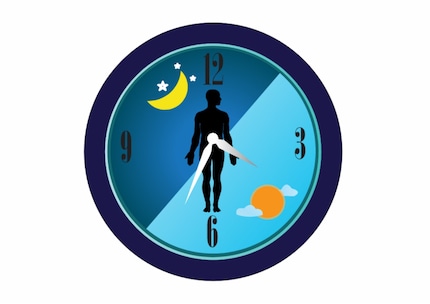
Background information
Colour is key – from light therapy to light pollution
by Anna Sandner

In a world full of artificial light, our inner clocks sometimes don’t tick quite right. In an interview, chronobiologist Henrik Oster explains how we can support our sleep-wake cycle.
Why do young people suffer from «social jet lag»? Do bright white LEDs really throw entire ecosystems out of balance? And we do, in fact, have multiple internal clocks? I talked about all this and more with Henrik Oster, PhD and head of the Institute of Neurobiology at the University of Lübeck. Henrik Oster is a chronobiologist and researches the sleep-wake rhythm (circadian rhythm) in humans. In the interview, he explains that the right timing is important in controlling our inner clock and advises us to accept that our sleep-wake rhythm is also genetically determined.
Do our internal clocks all tick the same or are there individual differences?
Henrik Oster, PhD and head of the Institute of Neurobiology at the University of Lübeck: There are differences, because to a certain extent, how our internal clock ticks is genetically determined. For some, it may tick a little slower, meaning it’s moved back a bit; for others, it may be moved forward. This can only be influenced to a certain extent. If someone is a pronounced late riser, we currently have no means of converting them into an early bird. It’s important to be aware that there are biological limits, and it might be a good idea to respect them.
So, my being a night owl and not a morning lark is genetically determined?
Precisely. We refer to that as «chronotypes»; early chronotypes are colloquially known as morning larks, late chronotypes as night owls. This can be measured using various methods. The gold standard is to, in a sleep lab, measure the onset of melatonin release in the evening, which is quite characteristic of the chronotype. A simpler method is to evaluate questionnaires about sleep patterns on hypothetical days off, i.e. when you can sleep whenever and for however long you please.
**Could I still become a morning lark? Does our chronotype change throughout our life? **
In general, the older you get, the less you sleep and the more fragmented your sleep becomes. Seniors over the age of 70 usually don’t sleep through the night. This is quite normal and is due, among other things, to the release of melatonin, which decreases with age. As a result, your net sleep time becomes shorter and shorter with increasing age. In addition, there’s typically a shift in the chronotype itself; not necessarily of sleep duration, but of sleep timing.
Research has found that during puberty the chronotype shifts backwards – towards night owl. This is statistically well proved. Your sleep rhythm can shift back by up to six hours.
Is this where the stereotype of the perpetually tired teenager comes from?
Yes, many young people live in opposition to their circadian rhythm because they have to get up early to be at school on time. As a result, they accumulate a kind of sleep deficit over the week, which they make up for on the weekend by staying in bed until noon. This is called «social jet lag», because you’re essentially flying to a different time zone on the weekend and then coming back. There are studies on school grades which show that late chronotypes in particular perform somewhat worse on average – at least in the subject of science.
People who very frequently and markedly go back and forth with their sleep time have also been shown to be more prone to addictive disorders, for example.
How is our circadian rhythm controlled?
You have a central internal clock that’s «set» by light. Information about brightness or darkness is transmitted to the brain directly via nerves in the eye. This happens in the so-called suprachiasmatic nucleus (SCN), a collection of nerve cells in the brain. However, there are many other types of circadian rhythms that are regulated by this central SCN clock.
Does our inner time always run at a constant speed?
Under typical circumstances, you’re in synch with the local time. There is a small adjustment every day, but you don’t actually notice it. It’s only when you switch time zones or there’s a shift to daylight saving time that you notice your internal time doesn’t line up with the external time.
The peripheral nervous system sends out various signals (e.g. hormones, but also autonomic, neuronal processes), enabling the SCN clock to influence all the other clocks in the body. This ensures that they, too, are in sync with the external time.
What else besides light influences our internal clock?
Stress, for example, or exercise, and the timing of your meals. These are all factors that can affect your internal clocks – but not always our central (SCN) clock. That one isn’t influenced by when we eat, for example.
So, what happens when it’s not our central internal clock that shifts?
If you were to eat at very unusual times (e.g. only at night), this would cause your liver clock and stomach clock to adjust – but not your SCN clock. This creates a kind of time difference within your body that’s unhealthy. If you work night shifts, for example, disturbance signals like this inevitably affect your internal clocks. Your body no longer knows which is the correct external time it should adapt to.
Does our central SCN clock respond to all forms of light?
Photoreceptors, that is, the sensors in your eye responsible for your internal clock, are particularly sensitive to blue light. They’re the most sensitive to wavelengths around 480 nanometres, i.e. blue light with a hint of green. Red light, on the other hand, doesn’t stimulate the photoreceptive ganglion cells in the retina at all. The SCN is blind to red light, so to speak.
And our other internal clocks don’t respond to light at all?
That’s an interesting debate, actually. Can clocks other than the SCN also respond directly to light, or do they only receive the light signal via the SCN? This has yet to be conclusively determined. In fact, there is a body of work that points to extra-retinal (i.e. outside the eye) light reception. Your skin, for example, can also react to light. However, there’s no consensus on whether this changes the molecular-genetic clocks in your skin.

If you spend time in front of a screen in the evening, the blue light inhibits melatonin production, preventing your body from becoming tired. Does this also apply the other way around, that is, can I use my computer screen to achieve the same effect as with a light therapy lamp?
That’s not a bad idea. However, while it does work in the same direction, I wouldn’t go so far as to say it has the same effect. In any case, timing is important in explaining the effect of blue light on your internal clock. When you see blue light in the evening, it slows down your internal clock, so your internal time shifts back. When you see light again the next morning, is has the opposite effect: your internal clock accelerates.
Here’s the thing: delaying your internal time in the evening with blue light, be it in your room lighting, on your phone, computer or television, also delays sleep onset. This is very counterproductive, especially if you already have problems falling and staying asleep. There are also psychological aspects to consuming content such as news or social media; it can be agitating and not conducive to sleep.
But in the morning, the light from our screens can help us wake up?
Yes, in the morning, the blue light moves your clock forward. This can help with seasonal depression, for instance. That’s why it’s recommended that those affected sit in front of a light therapy lamp in the morning. Phone and computer screens also have this effect, but at a lower light intensity. Daylight lamps are typically much brighter, and hence the effect stronger.
Can we still help our inner clocks with light therapy in the afternoon?
A light therapy lamp isn’t of much use in the early afternoon. The effect on your internal clock, in any case, will be very low, as it’s insensitive to light at noon. It can only adapt to the peripheral phases of night. All this to say, timing is important.
So, doesn’t it help our internal clocks at all if we go for a walk at noon to make sure we get enough light even in winter?
Precisely. In this case, the effect is purely psychological. It’d be better to go out first thing in the morning.
We always hear of melatonin in connection with the sleep-wake cycle. Are there other messenger substances that are important in this process?
The fact that melatonin is so often discussed is partly down to pragmatic reasons. Namely, melatonin lends itself to being measured in humans. And it is an important signal of time, though not essential. It plays a role primarily in seasonal adaptation, that is, adaptation to summer and winter and to different lengths of day and night.
But there are definitely other hormones that are also important. For example, cortisol, which is also very strongly circadian. Cortisol concentration peaks in the morning and reaches its low point in the evening. Unless we’re highly stressed, that is, in which case we produce more cortisol in the evening, too.
Are there any other hormones that play a role?
Insulin is also relevant. It’s released when you eat carbohydrates and can, for example, affect the clocks in your liver and other digestive organs. Your SCN clock, in turn, can regulate your eating times via the sleep-wake cycle, indirectly affecting insulin. Of course, when we’re asleep, we can’t eat; our insulin signal is suppressed at certain times. This can then influence your peripheral clocks.
What are you currently researching?
We’re looking at cortisol. In particular, at the interaction of your internal clocks with your stress system. For example, we’re investigating how stress affects physiological processes in the body at different times of day – and whether there are times of day when we’re more susceptible to stress. But cortisol not only conveys signals in acute stress situations; it can also suppress the immune system. That’s why we’re also examining its long-term effects.
Does cortisol also perform other functions in our body?
Cortisol also has important metabolic functions. If you produce too much cortisol on a sustained basis, your fat reserves get redistributed and the energy storage processes in your liver change. Finally, cortisol also has important effects on the brain, at least if you suffer from chronic stress. This translates into a high probability of developing depression. We’re interested in whether it’s possible to generate resilience against such diseases by strengthening your cortisol rhythm.
Let’s take a short detour into the animal and plant world. Bright LEDs are increasingly being used in street lighting. This upsets the circadian rhythms of many living things. Is it possible to use LEDs and save energy without upsetting the internal clocks of entire ecosystems?
Yes. Technically speaking, it’s no problem to shift the spectrum of the LEDs into the longer wavelength range. That would push them out a bit of this zone that’s sensitive for the circadian system. Instead of bright blue-white, the light would then be more yellow-orange. From an urban planning perspective, however, there are safety concerns with lower brightness; fewer crimes occur in well-lit places, hence people feel safer. In addition, the cool white LEDs appear to be the standard and are therefore cheaper for municipalities. But it would be quite possible to change the LEDs, and initial discussions to do so have already begun. People have long ignored the impact on nature, but a change in thinking is taking place.
To end off, do you have any tips on how we can do something good for our internal clocks?
The most important thing is to become aware of your inner clock and listen to your body. Ask yourself, which chronotype am I – early or late? How much sleep do I really need? Am I more of a long sleeper or short sleeper? If you accept this as a part of you with a genetic component to it that you can’t simply control with an alarm clock, then you’re already on the right path.

Header image: Shutterstock
Science editor and biologist. I love animals and am fascinated by plants, their abilities and everything you can do with them. That's why my favourite place is always the outdoors - somewhere in nature, preferably in my wild garden.
Interesting facts about products, behind-the-scenes looks at manufacturers and deep-dives on interesting people.
Show all